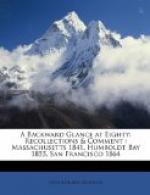The “Paragon” soon found heavy weather and was driven far out to sea. Then for three days she was in front of a gale driving her in shore. She reached the coast nearly at the Oregon line and dropped anchor in the lee of a small island near Point St. George. In the night a gale sprang up, blowing fiercely in shore toward an apparently solid cliff. One after another the cables to her three anchors parted, and my father said it was with a feeling of relief that they heard the last one snap, the suspense giving way to what they believed to be the end of all. But there proved to be an unsuspected sandspit at the base of the cliff, and the “Paragon” at high tide plowed her way to a berth she never left. Her bones long marked the spot, and for many years the roadstead was known as Paragon Bay. No lives were lost and no property was saved. About twenty-five of the survivors returned to San Francisco on the “Cameo,” but my father stayed by, and managed to reach Humboldt Bay soon after its discovery, settling in Uniontown in May, 1850.
The glory of the ocean discovery remained for the “Laura Virginia,” a Baltimore craft, commanded by Lieutenant Douglass Ottinger, a revenue officer on leave of absence. She left soon after the “Paragon,” and kept close in shore. Soon after leaving Cape Mendocino she reached the mouth of Eel River and came to anchor. The next day three other vessels anchored and the “General Morgan” sent a boat over the river bar. The “Laura Virginia” proceeded north and the captain soon saw the waters of a bay, but could see no entrance. He proceeded, anchoring first at Trinidad and then at where Crescent City was later located. There he found the “Cameo” at anchor and the “Paragon” on the beach. Remaining in the roadstead two days, he started back, and tracing a stream of fresh-looking water discovered the mouth of the Klamath. Arriving at Trinidad, he sent five men down by land to find out if there was an entrance to the bay he had seen. On their favorable report, Second Officer Buhne was instructed to take a ship’s boat and sound the entrance before the vessel should attempt it. On April 9, 1850, he crossed the bar, finding four and a half fathoms. Buhne remained in the bay till the ship dropped down. On April 14th he went out and brought her in. After much discussion the bay and the city they proposed to locate were named Humboldt, after the distinguished naturalist and traveler, for whom a member of the company had great admiration.
Let us now return to L.K. Wood, whom we left at the Mark West home in the Sonoma Valley, recovering from the serious injuries incident to the bear encounter on Eel River. After about six weeks of recuperation, Wood pushed on to San Francisco and organized a party of thirty men to return to Humboldt and establish a settlement. They were twenty days on the journey, arriving at the shore of the bay on April 19th, five days after the entrance of the “Laura Virginia.”




